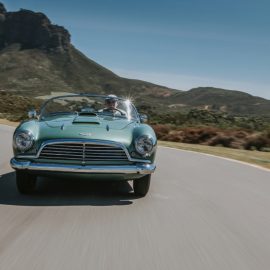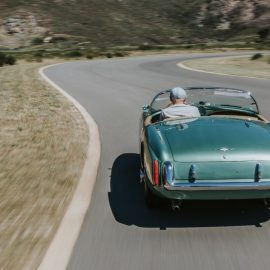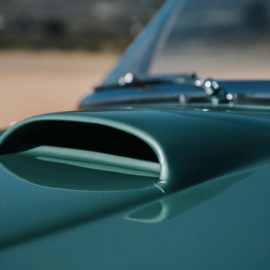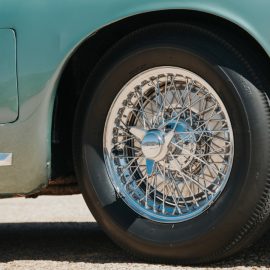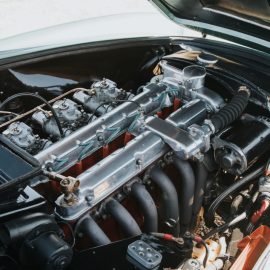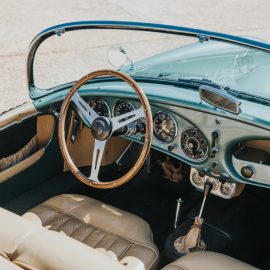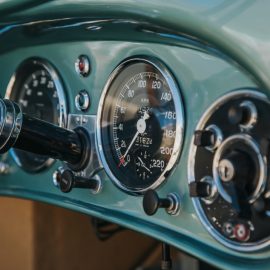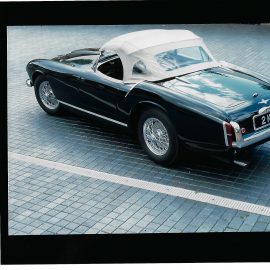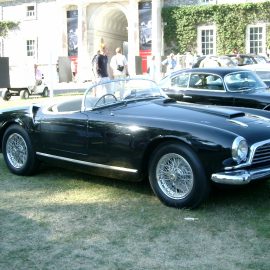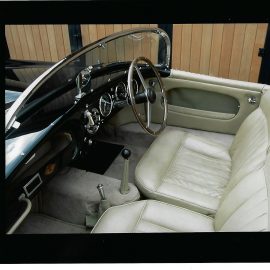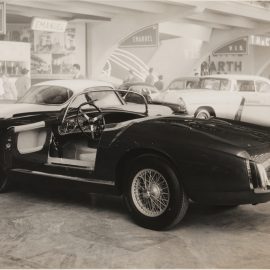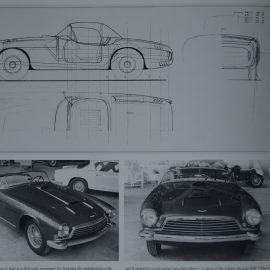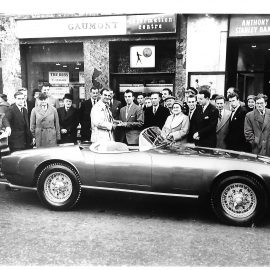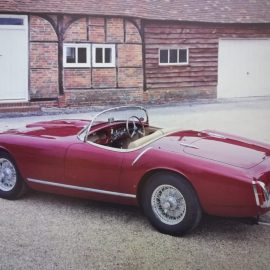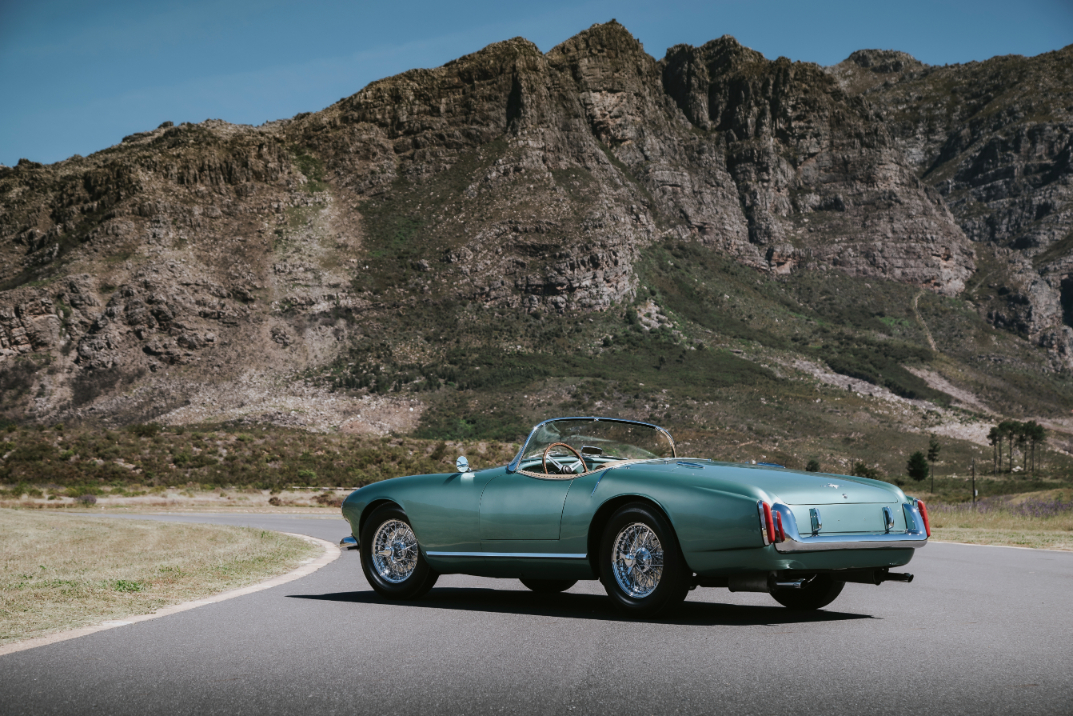
31 Jul Touring Spyders – Part 2
Part 2 of a three part story behind a trio of Aston Martin DB2/4 Mk.IIs that were sent to Carrozzeria Touring of Milan in 1955 to be fitted with some distinctive and innovative Superleggera bodywork. This month’s featured car is the one that is now part of the FMM collection…
Painted a light metallic leaf green, AM300/1162 (body number 4344) appeared at the Paris Motor Show, which opened at the Grand Palais on 10 October 1956. There were some minor styling differences, most noticeably the mudguard vents were not fakes, and the size of the boot lid was different with the handle in a more rearward position. The reason for this was that on 1161 it was not possible to use the spare tyre lever to raise the wheel from its storage position under the car. Consequently, the size of the boot lid was enlarged by neatly welding on a full width extension and relocating the handle high up on the boot lid, as can be seen in the photographs. Certainly a neat job.
After the show, 1162 was sold to Aston Martin’s Paris agent, Garage Mirabeau, which seems to have later sold the car to George S Livanos, uncle of the Greek shipping tycoon Peter G Livanos who, as fate would have it, went on to purchase the Aston Martin company in 1983.
A Geoffrey Goddard photo exists of a Touring Spyder alongside the factory team entries for the 1956 Le Mans 24-Hour held at the Circuit de la Sarthe on July 28-29, but which Spyder has not been confirmed. However, in the race, the Peter Walker/Roy Salvadori factory Aston DB3S crashed after 16 hours racing and, at some point, 1162’s twin-cam 2 922 cm3 inline-6 engine was upgraded to DB3S specification with triple Weber 35DCOE carburettors, high-performance camshafts and a finned aluminium sump. It was the only Spyder to have this modification, which surely is more than a coincidence. The conversion was allegedly carried out by Garage Mirabeau, whose commercial director was Claude Le Guezec, a talented French racing driver. As a result, 1162’s peak power output was raised to 133 kW (178 bhp) at 5 500 r/min, and top speed to 212 km/h (132 mph).
Quite what happened to 1162 for the next 10 years of its life is unknown. However, black-and-white photos exist of one of the three cars parked in London with left-hand drive and the Paris registration number 796-TTB75. The accompanying caption of the light-coloured car states the photo was taken in 1957, which means it must be 1162 because by this time 1161 was already converted to right-hand drive, and 1163 (the third and last to be built) was painted white, which would be more obvious in the image. Add this to the fact that the car belonged to Garage Mirabeau after the show further suggests it is 1162.
Then in 1966, Dr John Spriggs of Philadelphia found the car on a used car lot in Camden, New Jersey. The Aston Martin Quarterly magazine quoted Spriggs as saying, “It seemed so unusual that I bought it and decided to restore it”. In 1968, he took the revamped car, now painted maroon, to the New Hope Auto Show in Pennsylvania, and in the September to an Aston Martin meet in Harrisburg, Eastern Pennsylvania, where it took second place in the concours. Whitman Ball was at this event and fell in love with its shape, saying “I think it’s the prettiest of the post-war custom-built Astons”. The car was by now for sale but Whit could not then afford the asking price of $6 000, so it went to a new owner in the Midwest before being sold on again to someone in Fort Collins, Colorado, after which its trail of ownership again goes cold…
Until it was found in 1983 – under a tarpaulin in a wrecking yard in Salt Lake City, Utah where, astonishingly, it had been languishing since 1971. Whit’s friend Charlie Turner, from Atlanta, sent him some pics of the abandoned Spyder, which had been bought by the yard’s owner as part of a settlement and put to one side as a future restoration project. On this occasion, Whit, who lives in Exton, Pennsylvania, did not hesitate to buy the car, which was “in a pretty rough state. The leather upholstery was as hard as a rock, the bumpers had disintegrated but, amazingly, there was no chassis rust. It needed a full restoration and the original engine was waiting to be finished”. A spare engine was purchased as back-up and a four-year renovation was undertaken, including repainting it in its original light green; Whit found traces of the original paint in the passenger footwell and was able to match the colour exactly.
Once completed, in August 1987 Whit took the car to the Pebble Beach Concours and won second in class. The car appeared at Laguna Seca, took third place at the Baltimore Concours and won second in class as well as being voted the Most Popular Car by club members at the Aston Martin Owners Club gathering in Monterey. Chassis 1161 (which was featured in last month’s FMM newsletter) was also in attendance at Monterey, as was Felice Bianchi Anderloni, who apparently ‘practically went into orbit when he saw the two cars together’. While taking part in a slow drive-past, Whit passed a group of ladies, one of whom said, “My husband made that car”. They exchanged an “Hello” but Whit had to keep moving and did not see Mrs Anderloni again… The same year the car was third at the AAAC Hershey Concours.
Further successes followed in 1988 including first place at the AMOC Spring Concours in New Jersey, third in class at the Baltimore Concours, and in July took a brace of victories in the Lime Rock Speed Trial and Autocross. The car was also awarded the Inskip Trophy for ‘Best Overall Performance – Concours and Track’ and the Ziebart Trophy, presented to the Aston Martin deemed most deserving in the concours, regardless of class or placement. 1988 ended on a high with first place at the New Jersey AMOC Spring Concours.
In September 1989, 1162 was the only Aston Martin that took part in the inaugural Colorado Grand 1000 Mile Rally. In 1990, the car again took first in the Lime Rock Speed Trials and competed in the VSCCA Spring Meeting and Pocono 1-Hour Enduro, where it finished sixth in class. At the Meadowbrook Concours held in Oakland, Michigan, in 1992, the car received the Peter Helck Award for First Place in the ‘Circle of Twelve’. On the same weekend it was also entered in the Concours in the Park in Clarkson, Michigan and took a first prize as well as finishing first in class in the Historic Races at Clarkson’s Waterford Hills race track to complete a hat-trick of successes. A notable achievement.
Thereafter, running his burgeoning antique hardware reproduction and restoration company precluded Whit from being as active on the motoring scene, but he did attend a number of Aston Martin gatherings and took part in the 1993 Colorado Grand Rally. He kept the car until 1998 when he sold it by private auction to a Chicago collector, Dennis J Machul, who then passed it on to the Blackhawk Collection in Danville, California in 2004. The Franschhoek Motor Museum then stepped in and purchased the car in November 2016, and the car is now one of the museum’s prized possessions and is regularly exercised and put on display.
Visitor Note: FMM’s Aston Martin Touring is currently on view in Hall D.
(NB: This narrative is part of my original story of all three cars that was submitted to and published in the Issue 33 Spring 2021 edition of Vantage, the independent Aston Martin magazine, but contains more detail. This serialisation is used with the kind permission of Vantage magazine – MM).




